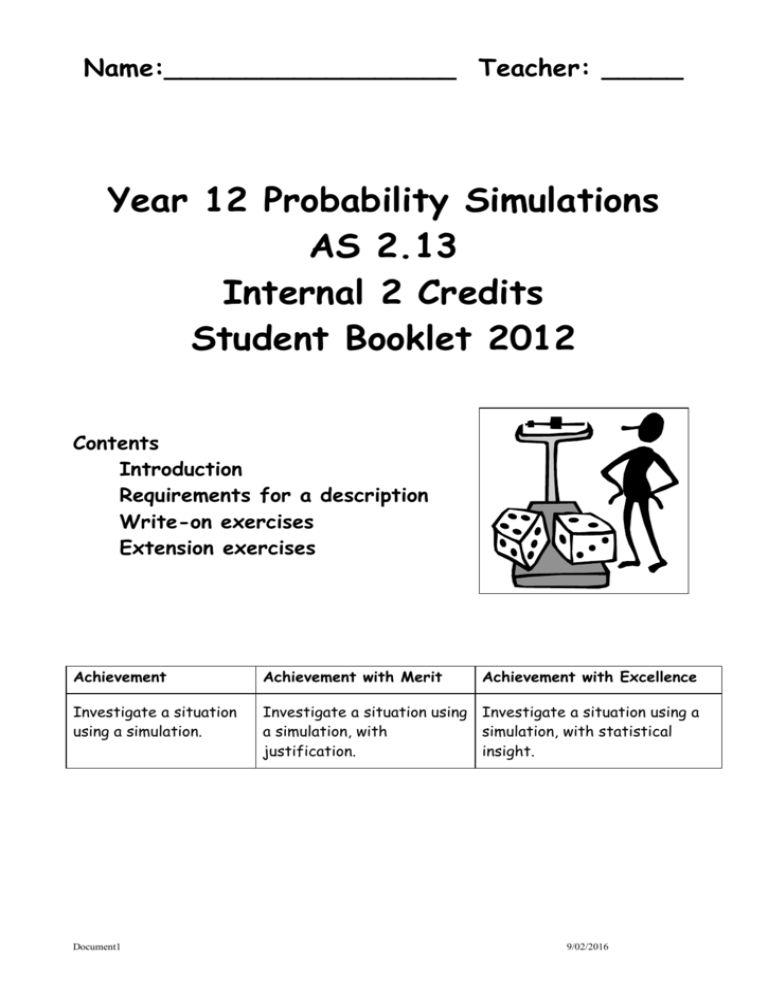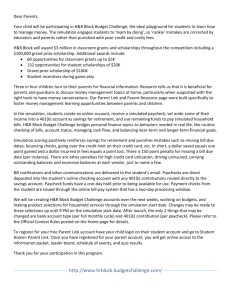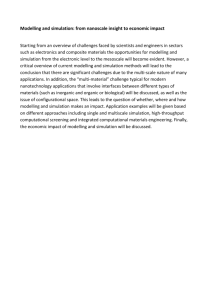Simulation booklet 2012 - Auckland Mathematical Association
advertisement

Name:__________________ Teacher: _____ Year 12 Probability Simulations AS 2.13 Internal 2 Credits Student Booklet 2012 Contents Introduction Requirements for a description Write-on exercises Extension exercises Achievement Achievement with Merit Investigate a situation using a simulation. Investigate a situation using Investigate a situation using a a simulation, with simulation, with statistical justification. insight. Document1 Achievement with Excellence 9/02/2016 Epsom Girls Grammar School Mathematics Learning Area Achievement Achievement with Merit Achievement with Excellence Students will show evidence of investigating the situation using each component of the simulation process. Students will show evidence of investigating the situation using each component of the simulation process, linking this to the context, explaining the relevant design considerations made in the design and supporting findings. Students will show evidence of investigating the situation using each component of the simulation process, integrating statistical and contextual knowledge throughout the process. This will mean: designing the simulation for the given situation, identifying the tools to be used, defining what is a trial and the number of trials, determining the data recording methods; carrying out the simulation and recording the outcomes; selecting and using appropriate displays and measures; and communicating findings in a conclusion. In their report the student should show evidence that they have: Designed the simulation for the situation given. They have specified the tools to be used, what a trial is, the number of trials and the data recording method. Conducted the initial simulation and recorded the outcomes. Selected and used appropriate displays and measures. Communicated findings clearly, making a conclusion relating to the simulation. Document1 This will mean: designing the simulation for the given situation, identifying the tools to be used, defining what is a trial and the number of trials, determining the data recording methods; carrying out the simulation and recording the outcomes; selecting and using appropriate displays and measures; and communicating findings in a conclusion. This will mean: designing the simulation for the given situation, identifying the tools to be used, defining what is a trial and the number of trials, determining the data recording methods; carrying out the simulation and recording the outcomes; selecting and using appropriate In their report the student should displays and measures; and show evidence that they have: communicating findings in a Designed the simulation for the conclusion. situation given. They have In their report the student described in detail the tools to should show evidence that be used, what a trial is, the they have: number of trials and the data Designed the simulation for recording method. They have the situation given. They identified at least two have described in detail the assumptions in designing their tools to be used, what a trial simulation. is, the number of trials and Conducted the initial simulation the data recording method. and recorded the results and They have identified at least repeated the simulation one assumption in designing Selected and used appropriate their simulation. displays and measures. They Conducted the initial have discussed the overall simulation and recorded the aspects of the distribution or results and repeated the simulation. simulation. Communicated findings clearly, Selected and used and linked the recommendation appropriate displays and clearly to the results of the measures. both simulations. They have Communicated findings discussed more than one aspect clearly, and linked the of the recommendation with recommendation to the respect to the context of the results of the simulations. simulation in depth. 9/02/2016 -2- Epsom Girls Grammar School Mathematics Learning Area Introduction Simulations are used to solve probability problems when it is difficult to calculate the answer theoretically. You may be asked to calculate The long run frequency of an event happening The average number of times needed to carry out a ‘trial’ until a certain condition is met Simulation Tools When designing a simulation a tool must be chosen that matches the situation. Possible tools include Coins, Dice, Spinners Random number tables Random numbers on the calculator Random number generator on a spreadsheet Random numbers on the calculator The RAN# button produces random numbers from 0 to 0.999 999 999 9. It is possible to use the random numbers generated directly (see your teacher) or you can tailor the numbers to the specific problem. Instructions are given here for the Casio Graphics Calculator fx-9750. MENU RUN (1) OPTN F6 (>) PROB (F3) (n+1)Ran# EXE (ie one more than the greatest number required, then F4) Eg to generate Lotto numbers between 1 and 40: 41Ran# EXE , taking only the digits before the decimal place and ignoring 0. Keep pressing EXE until you have the required number of random numbers. Eg to simulate a situation where there is a 14% chance of success 101Ran# EXE , taking only the digits before the decimal place and ignoring 0, allocating 1 to 14 for success, 15 to 100 for failure Keep pressing EXE until you have the required number of random numbers. Your teacher may teach you other methods for using your calculator or to use tables of random numbers when technology fails. Document1 9/02/2016 -3- Epsom Girls Grammar School Mathematics Learning Area Towards achievement in Achievement Standard 2.13: Investigate a situation using a simulation. To describe a simulation you should cover the following five aspects: Tool: Trial: Results: State which tool you will use. State how the tool will be used to model the situation. State what one trial consists of. State how you will recognise success. State how many trials you will do. Draw up a table to present your results. Use clear headings. Generally you should do at least thirty trials. Include any random numbers you generate. Calculation: Carry out the calculation required to solve the problem Answer: Answer the question (read it again first) Document1 9/02/2016 -4- Epsom Girls Grammar School Write-on exercise 1 Mathematics Learning Area The Three Child Family Problem: What is the probability that a 3-child family will contain exactly two boys and one girl? You may assume that a boy or girl is equally likely to be born. Tool: ________________________________________________________________ ________________________________________________________________ Trial: ________________________________________________________________ ________________________________________________________________ Results (for example if a 2 represents a boy; you are to do your own trials): Trial Outcome of trial Two boys exactly 1 122 yes 2 111 no 3 Write your results in your book. Calculation: ________________________________________________________________ ________________________________________________________________ ________________________________________________________________ Answer: Use the results of your simulation to answer these questions: In 250 3-child families how many would you expect to have a) Exactly 2 boys ________________________________________________________________ ________________________________________________________________ ________________________________________________________________ b) All girls ________________________________________________________________ ________________________________________________________________ ________________________________________________________________ We could answer the question “What is the probability that a 3-child family will contain exactly two boys and one girl?” more easily by drawing a probability tree and working out the theoretical probability. From now on we will only do simulations of situations where we can’t easily work out the theoretical probability. Document1 9/02/2016 -5- Epsom Girls Grammar School Write on Exercise 2 Mathematics Learning Area Breakfast Gifts Problem: A cereal manufacturer includes a gift in each packet of cereal. There are four different gifts. What is the expected number of packets of cereal you must buy to collect all four different gifts? Assumption: the gifts are randomly distributed in the boxes of cereal and each gift is equally likely to be in a box. Tool: ________________________________________________________________ ________________________________________________________________ ________________________________________________________________ Trial: One trial consists of Generating random numbers on the calculator until at least one of each number 1 to 4 turns up The number of packets of cereal required is recorded 30 trials will be done Results: Trial 1 2 The results will be tabulated as follows (for example): Outcome of trial 21113214 334114432 Number of packets 8 9 Write your table of results in your book. Calculation: Estimate of the number of cereal packets needed: average number of packets = total the number of packets for the 30 trials = 30 Answer: Document1 9/02/2016 -6- Epsom Girls Grammar School Mathematics Learning Area Exercise 4 A Woolly Task Farmer McDonald wants to know the average number of lambs produced by his special flock of 720 breeding seasons. Assume that each ewe produces either a single lamb or twin lambs. From records of past breeding seasons Farmer McDonalds knows that the probability of breeding twins is 1/6. 1. Design a model to simulate the lamb production of a ewe for 5 successive breeding seasons. Describe the steps you will take in sufficient detail so that the farmer can repeat it without your help. 2. Carry out simulation by conducting 30 trials and recording your data. 3. Use the results of your simulation to find the mean number of lambs produced by an ewe over the four seasons. 4. Use the results of your simulation to estimate the number of ewes in this flock that have at least two sets of twins given that they have twins in the first season. 5. Farmer McDonald is kind to his sheep, so an ewe which has produced two sets of twins will no longer be used for breeding. Use the results of your simulation to estimate the number of ewes (in the flock of 720) that will still be used for breeding after 3 years. 6. What are the limitations of the model you have chosen in predicting the number of lambs produced by the McDonald flock over several years? Give at least two limitations. Bob’s ties Exercise 5 Problem: Bob has 7 different ties. He works a five day week in the office of the Inland Revenue. Design and carry out a simulation to calculate the probability that Bob wears the same tie more than once in a five day week. You may assume that he chooses a tie randomly each morning. Exercise 6 Oil Strike Problem: Suppose that the probability that an exploratory oil well will strike oil is 0.2 and that each exploratory well costs 5 million dollars to drill. How many of the next 20 wells established will have cost at least 25 million dollars for their exploration? Document1 9/02/2016 -7- Epsom Girls Grammar School Exercise 7 Mathematics Learning Area Boys wanted! Problem: In many countries around the world, couples look to a son to take care of them in their old age. For this reason they keep having children until they give birth to a son. This can lead to over-population. However, suppose a government permits people to continue having children until they have exactly one son. Design and carry out a simulation to answer the following questions: a) What is the average number of children per family in these circumstances? b) What is the probability that a couple will have three children without having a boy? Exercise 8 An Infectious Disease The speed of an infectious disease can be modelled as follows. Suppose that an infectious disease has a one-day infection period, and after that a person is immune. Six people live on an otherwise deserted island. One person catches the disease and randomly visits one other person at random during the next day (his infection period). The process continues, with one visit per day, until an infectious person visits an immune person and the disease dies out. Design and carry out a simulation to solve the problem. Write down all 5 steps (TTRCA). Construct at least 30 trials of the simulated epidemic. Use the simulation results to answer the following questions. (a) (b) (c) (d) What is the average number of people who get disease in your simulated epidemic? What is the probability that more than 3 people will get the disease? What is the probability that all six people get the disease? What are the limitations of the model you have chosen in predicting the number of people catching the disease? Give at least two limitations. Document1 9/02/2016 -8-







